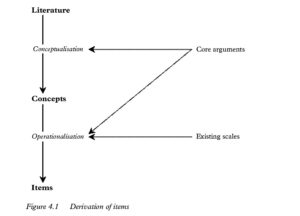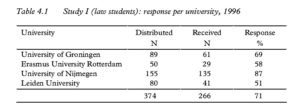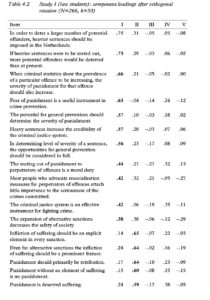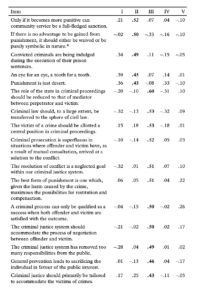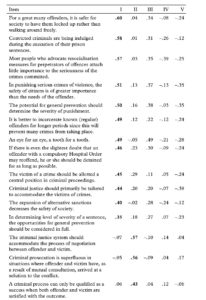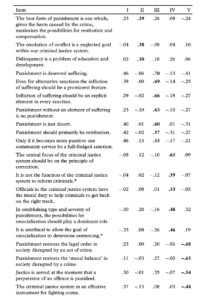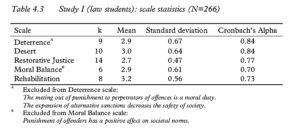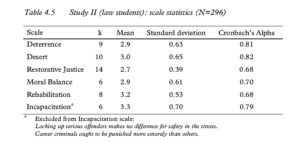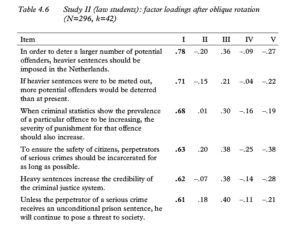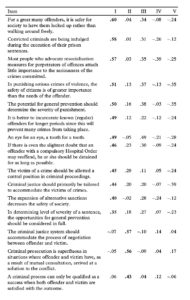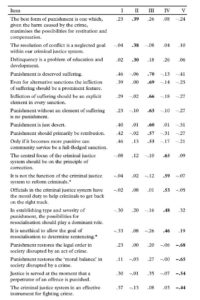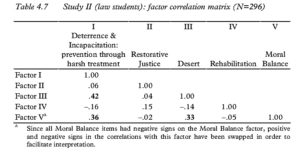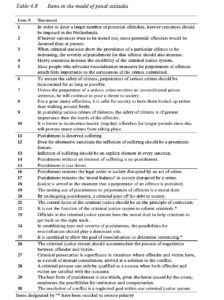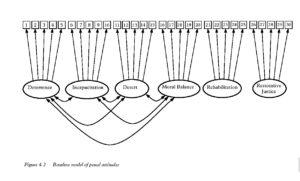Punishment And Purpose ~ Development Of A Measurement Instrument
 4.1 Introduction
4.1 Introduction
In Chapter 3, the concept of penal attitude was examined in some detail. Furthermore, the point was made that, while research on psychological characteristics of magistrates is quite common in some other countries (e.g. United States, England, Canada, Germany), in the Netherlands this type of research seems to be a ‘blank spot’ (Snel, 1969). The few (predominantly qualitative) studies that were carried out have led to rather inconclusive results concerning magistrates’ penal attitudes. Furthermore, no systematic quantitative study on this topic has been carried out in the Netherlands thus far. We consider this to be a serious deficiency in criminological and psychological research on the Dutch magistrature.
The present chapter therefore focuses on the systematic process of developing a theoretically informed measurement model of penal attitudes. Section 4.2 discusses the measurement approach that we have adopted. However, our approach, like any other, is accompanied by a number of methodological and practical concerns. Each of these will be given due attention. Section 4.3 elaborates on the process of translating the relevant theoretical concepts into measurable variables (i.e., operationalisation) resulting in an initial version of the measurement instrument. In Section 4.4, the procedure and results of the first application of the instrument with Dutch law students (N=266) are discussed. Implications of this study for subsequent refining or revising the measurement instrument are then considered in Section 4.5. Section 4.6 describes the further steps in the development of the measurement instrument. The procedure and results of a second empirical study with Dutch law students (N=296) are reported. The results of this second study are compared to those of the first study thus allowing a measure of reliability (i.e. replicability) to be obtained. Finally, in Section 4.7, results of the second study with law students are used as the foundation for a basic (structural) model of penal attitudes. To further validate the measurement instrument, to confirm results of the studies with law students and to explore the structure of penal attitudes, this model will be tested in Chapter 6 using data collected from judges in Dutch criminal courts. The position we adopt is that the development of a theoretically integrated model of penal attitudes contributes to a better understanding of how moral legal theory becomes translated into practice by criminal justice officials.
4.2 Measurement approach
We have opted for a quantitative approach to the measurement of penal attitudes. Several considerations guided this choice. The point of departure is a theoretical one. The interest is in determining whether concepts that are central in moral legal theories are measurable and meaningful for Dutch judges. Furthermore, we want to unveil the general structure of penal attitudes held by Dutch judges. These goals imply the use of (inferential) statistics which require quantitative data. We believe that a scaling approach designed to measure penal attitudes using more indirect questions (items) related to the theoretical concepts will yield most valid results. Given previous Dutch experiences with qualitative research involving judges’ views (see Section 3.4.2), the efficacy of such an approach for our purposes is questionable. The qualitative studies reviewed in the previous chapter show that Dutch judges (and prosecutors) rarely reveal their penal philosophies spontaneously. Direct questioning concerning magistrates’ penal attitudes mostly yielded superficial answers and showed that there was much confusion about the meaning of the relevant concepts. Our approach may shed more light on the personal views of judges than has been achieved with more qualitative approaches.
Research using such a quantitative approach has its own specific requirements related to validity, reliability and sample size. A further concern is related to the specific population of interest to the study. As a result of training and experience, judges tend not to think in terms of general problems in law and sentencing. Unlike the social scientist who aims at generality, judges are used to reasoning within the framework of a specific case. In other words, they are accustomed to interpreting and perceiving problems in the light of specific cases (Vranken, 1978). This may have consequences for judges’ perception of, and willingness to respond to, general questions in structured questionnaires.
Given our preference for a quantitative scaling approach to the measurement of penal attitudes, two further decisions needed to be made. The first was the choice between using single or multiple measures for measuring the relevant concepts. As discussed in Section 3.4, given reliability and validity problems related to single measures of theoretical concepts, multiple measures appear preferable. This choice seems to be especially relevant given the fact that most qualitative research found a lot of confusion among magistrates about the meanings of concepts related to functions and goals of punishment. A subsequent decision relates to the method for selecting suitable items. The choice between a phenomenological and a theoretical approach to selecting items was quite easy. Because of our explicit theoretical point of departure, a theoretical approach to item selection was the obvious choice. Moreover, the definition of our attitude objects (see Section 3.2) logically implies such a theoretical approach for selecting attitude statements.
4.3 Selection and formulation of attitude statements
The theories discussed in Chapter 2 represent our point of departure for the process of selecting and formulating attitude statements. Deriving attitude statements first involved conceptualisation of the theories, followed by a phase of operationalisation. Within each approach, we identified the central concepts. Given our discussions in Chapter 2, many of these concepts were quite evident from the outset. The process of identifying central concepts was further complemented and facilitated by studying and selecting core-arguments from the relevant theoretical literature. Such core arguments were statements taken from the literature which we believed to reflect the central issue(s) of a particular approach. At this empirical stage of the study we looked at the relevant theories from an operational point of view. This resulted in the decision not to consider some of the sophisticated metaphysical concepts and arguments for the measurement instrument.[i]
Conceptualisation was followed by operationalisation into attitude statements. The selected core-arguments from the literature and examples from some existing attitude scales constructed by others (cf. Carroll, Perkowitz, Lurigio, & Weaver, 1987; Hogarth, 1971; Ortet-Fabregat & Pérez, 1992) proved to be helpful tools for operationalising the theoretical concepts.[ii] Great care was taken to make sure that each theoretical concept was represented by multiple statements (items). In a later stage, statistical criteria were applied to select the best items from the initial item pool.
The process of conceptualising Utilitarianism resulted in the prevention of future crime through deterrence, incapacitation and rehabilitation.[iii] For Retributivism the central concepts were (just) desert, infliction of suffering, temporal perspective on past behaviour, and restoring the moral balance in society. The central concepts in the Restorative Justice approach were orientation on victim, active role for offenders, crime as a social conflict, reparation and compensation, and discontent with the current criminal justice system.
The expressive function of punishment (censuring and affirmation of norms)[iv] was found to play a role in all three approaches in one way or the other. Thus, because the expressive function of punishment is not expected to differentiate between the approaches, it was considered to be unsuitable for subsequent operationalisation.
Some examples of core arguments and final attitude statements for the relevant theoretical approaches best illustrate the process of conceptualisation and operationalisation. Examples of arguments from the utilitarian literature are:
The obligation of judges, correctional officials, and legislators to serve the public implies that they have a moral duty to try to reform offenders (…) (Glaser, 1994, P. 722). (P)unishments and the means adopted for inflicting them should, consistent with proportionality, be so selected as to make the most efficacious and lasting impression on the minds of men (…) (Beccaria, 1764/ 1995, p. 31).
Punishment must not be employed at all if it is inefficacious or unprofitable through creating more misery than it prevents, or if it is needless in the sense that the mischief of an offence can be checked by non-punitive measures and so at a ‘cheaper rate’ (Hart, 1982, p. lxi).
The above arguments reflect the concepts of rehabilitation, deterrence, and the guiding principle of utility. These arguments proved helpful in formulating the following attitude statements:
The central focus of the criminal justice system should be on the principle of correction.
The potential for general prevention should determine the severity of punishment. If there is no advantage to be gained from punishment, it should either be waived or be purely symbolic in nature.
Similarly, core-arguments from retributive literature were extracted. Arguments from retributive literature led to identifying, amongst others, the concept of moral balance. A disrupted moral balance can be restored through, for instance, annulling unfairly gained advantages.[v] Some resulting attitude statements are:
By means of punishment, an unfair advantage is annulled.
By undergoing punishment, a criminal pays off his debt to society.
The latter statement is an example of one inspired by an existing item used by Hogarth:
Criminals should be punished for their crime in order to require them to repay their debt to society (Hogarth, 1971, p. 130).
Concerning the Restorative Justice approach, examples of core-arguments selected from the literature are:
A new criterion for evaluating the process is introduced: that it should be satisfactory for both parties, not only the victim but also the offender (Wright, 1991, p. 113). Aiming at the resolution of a conflict and the reparation of the loss seems to be more constructive for social life than balancing an abstract juridico-moral order (Walgrave, 1994, p. 68).
Reparation should encourage the reintegration of victims into legal proceedings as individuals with justified claims. Victims should receive active support in obtaining reparation, and this right should have priority over punishment by the state (Messmer & Otto, 1991, p. 2).
These extracts from the Restorative Justice literature reflect some central concepts in this approach. Corresponding attitude statements include:
The victim of a crime should be allotted a central position in criminal proceedings.
The best form of punishment is one which, given the harm caused by the crime, maximises the possibilities for restitution and compensation.
The resolution of conflict is a neglected goal in our criminal justice system.
A criminal process can only be qualified as a success when both offender and victim are satisfied with the outcome.
Following this pattern, operationalisation of the main theoretical concepts resulted in an initial pool of 76 items. Before proceeding to apply the measurement instrument to a sample of law students, this pool of 76 attitude statements was further refined in two ways.
First, two Dutch criminal law students were given a questionnaire containing the 76 items.[vi] Each item could be responded to using a five-point scale ranging from 1 ‘completely disagree’ to 5 ‘completely agree’. After the students had completed the questionnaire, each item was extensively discussed in a subsequent evaluation session. They were encouraged to comment on any aspect of item-wording or content that they found unclear or confusing.
Second, after making the necessary adjustments to a number of items, the revised questionnaire was extensively discussed with a professor of criminal law at Leiden University who also works as a deputy judge.[vii] This latter session completed the fine-tuning phase.
4.4 Study I[viii]
The aim of this study was to explore and interpret the underlying structure in Dutch law students’ responses to the attitude statements. As such, the analyses would give a first indication of the usefulness of the measurement instrument. Is the instrument effective for consistently discerning various underlying concepts or, put in another way, can the instrument effectively measure penal attitudes? If the instrument would fail to discriminate between theoretically meaningful concepts, serious doubts either about the validity of the instrument or about the existence of the attitudes it is supposed to measure would have to be considered.
Furthermore, statistical criteria in conjunction with theoretical concerns have been used to select items from the initial pool of 76 items. In this way, the most adequate items for subsequent studies are singled out. Finally, results of Study I have been used to identify deficiencies in the measurement instrument which also led to necessary revisions that wouldhave to be made.
4.4.1 Data collection and sample
For study I, data were collected from (criminal) law students at the University of Groningen, Erasmus University Rotterdam, University of Nijmegen, and Leiden University. In February 1996, with the help of faculty staff, 374 questionnaires were distributed to students who were attending criminal law lectures. The questionnaire contained the 76 attitude statements in random order. Responses were to be given on five-point scales, ranging from ‘completely disagree’ to ‘completely agree’. Completed questionnaires were returned in pre-paid response envelopes. Students who returned the completed questionnaire received a giftvoucher with a monetary value of 10 Dutch Guilders (about US $ 5).
Within one month, 266 completed questionnaires were returned, yielding an overall response rate of 71 percent. Table 4.1 shows the response rates per university. The Table shows response rates to vary from relatively low in Leiden (51%) to exceptionally high in Nijmegen (87%). All questionnaires returned were completed with notably few missing responses. The average age of the law students in the sample is 22.9 years (standard deviation 3.3). More than half (52%) of the respondents were between 18 and 22 years old. The majority of the students in the sample were female (59%), with the Erasmus University Rotterdam showing the highest proportion of females (76%). Most students (64%) were either in their third or fourth year of law study. The remaining 36 percent were all second year law students from Nijmegen.
4.4.2 Analysis and results
Principal components analysis (PCA) with orthogonal (varimax) rotation of the axes was first used to explore the underlying structure in the data. [ix] Primary criteria for determining the number of principal components to retain were the ‘scree’ graph (a plot of the latent roots or ‘eigenvalues’ against components) and interpretability of components. Inspection of the ‘scree’ graph suggested retaining five principal components.[x] Interpretation of these five components was quite straightforward (see below) and related eigenvalues were greater than one. As such the analysis with the 76 items resulted in an initial solution with five principal components. Next, our aim was to select the most adequate items from the initial pool of 76.
Using statistical criteria, we wanted to identify items that contributed little to this solution and could therefore be left out of subsequent analyses. It was decided that items had to exceed a component loading of 0.4 on any of the five components after rotation. Twenty-six items that did not meet this criterion were removed. Further inspection of these 26 items, revealed that they could be considered either too complex or ambiguous in wording. Subsequently, the analysis was repeated with the 50 remaining items. The five principal components (after varimax rotation) resulting from the analysis on these items were essentially the same as in the initial analysis and were readily interpretable. These principal components accounted for 40% of the total variance in responses. Table 4.2 shows the 50 attitude statements and their respective component loadings on five principal components.
The first principal component involves items related to general prevention, mainly through (general) deterrence, and was labelled Deterrence. The second component contains items that refer to deserved suffering and ‘harsh treatment’. Subsequently, this second component was labelled Desert. All items which have high loadings on the third component relate to the various aspects of the Restorative Justice approach. Subsequently, it was labelled Restorative Justice. The fourth component involves items related to restoring a disrupted moral and legal order in society. It involves the general retributive justification for the practice of punishment (cf. Chapter 2). This component was labelled Moral Balance. The fifth and final component concerns statements which predominantly focus on personality and deficiencies of offenders and potential for reform or correction. This fifth component was labelled Rehabilitation.
According to this five-dimensional structure underlying responses to the attitude statements, summated rating scales were constructed. The items included in the scales are the same as the high loading items on the separate principal components in Table 4.2. To determine internal consistencies of the scales, item analysis was carried out. Cronbach’s Alpha was calculated for each separate scale.
Table 4.3 shows the scale labels, number of items included in each scale (k), means, standard deviations and Cronbach’s Alphas. For theoretical reasons, three items were excluded from the rating scales. These items are noted at the bottom of table 4.3. The reported means and standard deviations were computed after the summated scales had been divided by their respective numbers of items. The table shows that, in this study, Deterrence yields an Alpha of 0.84, Desert 0.84, Restorative Justice 0.77, Moral Balance 0.70, and Rehabilitation 0.73. These Alphas indicate internal consistencies of the scales to be ranging from quite acceptable to good.
Results of Study I suggest that Deterrence and Rehabilitation, stemming from the utilitarian approach, are clearly distinguishable and measurable components in penal attitudes. The retributivist items form two separate attitude scales: restoring the Moral Balance and Desert. Attitude statements referring to the various components of Restorative Justice all converge on one Restorative Justice dimension. As such, Restorative Justice is the only approach among the three that can empirically be represented by a single homogeneous attitude scale. Empirically, restorative justice, therefore, seems to offer a more integrated account of punishment than the other approaches. Through the process of item analysis, the five summated rating scales were shown to be internally consistent.
One of the goals of this study was to identify deficiencies in the instrument. Reviewing the scales that emerged from the analyses, reveals that one of the central concepts in the utilitarian approach, Incapacitation, did not emerge as a separate dimension. Instead, most incapacitation items were among the 26 removed after the initial analysis. Further inspection of the original incapacitation items led us to believe that the failure to reproduce this dimension is due to a flawed formulation of the relevant attitude statements. Since incapacitation is one of the central concepts in the utilitarian approach, it was decided to formulate a number of new Incapacitation-items for subsequent studies. The procedure adopted will be discussed in more detail in the next section.
The final question posed to the students asked them to report any difficulties they encountered in responding to the attitude statements. Almost 37 percent of the students responded to this question. Half of these responses were remarks concerning difficulties with the generalising and case-independent nature of the statements. This problem was anticipated in Section 4.2 above. Since all respondents conscientiously completed the questionnaires and response patterns appeared to be quite consistent and interpretable, the generalising nature of the statements seems to have been more of an annoyance to these students than a factor that seriously impeded the measurement. It was decided, however, that the generalising nature of the statements would need to be clearly justified and explained when dealing with judges in Dutch criminal courts.
In summary, the initial corpus of 76 items has been narrowed down to the 50 most adequate items. Principal components analysis and reliability analysis have shown these 50 items to form theoretically meaningful, readily interpretable and internally consistent scales for penal attitudes. However, new attitude statements pertaining to the utilitarian concept of incapacitation are required.
4.5 Revision
Before discussing procedure and results of the second study with law students, the formulation of a number of new Incapacitation items will first be discussed. This is an important step since the measurement instrument appeared to be seriously deficient in relation to this utilitarian concept.
The following procedure was used. A one-page questionnaire was distributed among all available colleagues at NISCALE (about 20). This number included some lawyers and a deputy judge. Some of the important general criteria which the formulation of attitude statements must meet (cf. McIver & Carmines, 1981; Swanborn, 1988) were first explained. Several examples of attitude statements were then given and the concept of Incapacitation was explained in some detail. Respondents were then asked to formulate one or more attitude statements pertaining to Incapacitation. This procedure produced 32 suggestions for statements. These were thoroughly reviewed after which eight statements were finally selected.
The resulting new attitude statements were:
* To ensure the safety of citizens, perpetrators of serious crimes should be incarcerated for as long as possible.
* For a great many offenders, it is safer for society to have them locked up rather than walking around freely.
* In punishing serious crimes of violence, the safety of citizens is of greater importance than the needs of the offender.
* It is better to incarcerate known (regular) offenders for longer periods since this will prevent many crimes from taking place.
* Unless the perpetrator of a serious crime receives an unconditional prison sentence, he will continue to pose a threat to society.
* If there is even the slightest doubt that an offender with a compulsory Hospital Order may reoffend, he or she should be detained for as long as possible.
* Locking up serious offenders makes no difference for safety in the streets.
* Career criminals ought to be punished more severely than others. These new items were incorporated in the questionnaire for Study II.
4.6 Study II
Study II was carried out with three objectives in mind. First, replicability of the five scales developed in Study I would be examined. Second, this study would signify a renewed endeavour to measure the important utilitarian concept of Incapacitation. The third objective of this study was to use the results as the foundation for formulating a baseline model representing the structure of penal attitudes. As such, Study II was to further the development of a theoretically integrated model of penal attitudes which is examined in Chapter 6 with data collected from Dutch judges.
4.6.1 Data collection and sample
For Study II, data were collected from (criminal) law students at two universities other than those used in Study I. It concerned the University of Utrecht and the University of Amsterdam. In January 1997, with the help of faculty staff, 496 questionnaires were distributed among law students attending criminal law lectures. The questionnaire contained 58 items in random order: 50 items from Study I plus eight new Incapacitation items.[xi] As in study I, responses were to be given using five-point scales ranging from ‘completely disagree’ to ‘completely agree’. Completed questionnaires were to be returned in pre-paid response envelopes. After returning the completed questionnaire, respondents received a giftvoucher with a monetary value of 10 Dutch Guilders (about U.S. $ 5).
The number of returned questionnaires was 296 in total, yielding a quite acceptable response rate of 60 percent. Table 4.4 shows response rates per university.
The average age of the law students in the sample was 23.2 (standard deviation 4.7) with 80 percent of the sample being between 18 and 24 years old. Furthermore, like in the first study, the majority (60%) of the law students was female. The proportion male to female students was roughly the same at both universities. The majority of respondents were either in their second (39%) or third (39%) year of law study. The remaining respondents were fourth year law students.
4.6.2 Analysis and results
The first goal of Study II was to examine the replicability of the rating scales extracted in the previous study. Five attitude scales, identical to those constructed in Study I, for Deterrence, Desert, Restorative Justice, Moral Balance, and Rehabilitation were formed and internal consistencies were re-examined. Furthermore, item analysis was carried out with the eight new Incapacitation items in an attempt to form an internally consistent rating scale for this concept.
Table 4.5 shows the scale labels, number of items included in each scale (k), means, standard deviations and Cronbach’s Alphas. As in the previous study, reported means and standard deviations were computed after the summated scales had been divided by their respective number of items. Results indicate that although most Alphas have dropped somewhat in value in comparison to those in Study I, the scales retain quite acceptable to good internal consistencies, with Cronbach’s Alpha’s ranging from 0.68 to 0.82. In other words, the scales of attitudes toward Deterrence, Desert, Restorative Justice, Moral Balance, and Rehabilitation, developed in Study I, have been shown to be replicable and to remain internally consistent with a different sample of law students.
Concerning the Incapacitation items, a scale including all eight items yielded a Cronbach’s Alpha of 0.72. Item analysis, however, revealed two items with very low corrected item-total correlation (0.16 and 0.11). Excluding these two items significantly improved internal consistency of the scale, resulting in an Alpha of 0.79. The excluded items are shown at the bottom of Table 4.5.
In summary, theory-based attitude scales have been constructed, refined and replicated. The scales display good internal consistencies. The central constructs in the three moral theories of Utilitarianism, Retributivism and Restorative Justice are meaningful and measurable concepts in the minds of Dutch (criminal) law students.
The true litmus test for the tenability of this theoretically integrated measurement instrument, however, must lie in the measurement of penal attitudes among judges. The third objective of Study II was therefore to use these data as the foundation for a baseline model representing the structure of penal attitudes. To further validate the measurement instrument, confirm results of the two studies with law students and examine the structure of penal attitudes, the baseline model was to be tested with data collected from judges in Dutch criminal courts. The development of this baseline model of penal attitudes using data from Study II is discussed in the next section.
4.7 Towards a structural model of penal attitudes
This section discusses the development of a baseline model of penal attitudes. The model is tested in Chapter 6 as a ‘structural equation model’. The purpose of constructing a structural model of penal attitudes is twofold. First, based on the results of the studies with law students, an attempt will be made to empirically confirm the structure of penal attitudes using data obtained from judges in Dutch criminal courts. Second, it is believed that a model of this type will deepen theoretical and empirical insights in the structure of penal attitudes among criminal justice officials.
Since the anticipated sample size of the study among magistrates was fairly Limited[xii], parsimony in the number of items to be selected for the structural model was an important concern. It was decided that factor analysis on the data of Study II using oblique (‘direct oblimin’) rotation of the axes would be the most appropriate technique for selecting items and modelling correlations between the underlying concepts. Factor analysis is the appropriate technique at this stage because it explicitly assumes the existence of an underlying theoretical structure. Analysis with oblique rotation allows for theoretically meaningful correlations between rotated factors. Furthermore, the analysis enables the researcher to formulate and apply objective criteria for excluding items.
Prior to the dimensional analysis, frequency tables of the separate items were inspected. Two restorative justice items[xiii] invoked relatively little variance in responses. Relatively few students agreed on these items while the others showed variations in degree of disagreement. Although these two items have been included in the Restorative Justice summated rating scale, the radical nature of these items was expected to invoke less variance among responses of Dutch judges relative to other Restorative Justice items. Given our concerns for parsimony in selecting items for inclusion in the structural model, the decision was made to exclude these two items from factor analysis and instead focus on items that were expected to invoke more variance in responses. The two Incapacitation items with low item to total correlations were also not considered for further analysis. The remaining 54 items were subsequently factor-analysed.
Concern for interpretability in combination with inspection of scree plots and eigenvalues (cf. Section 4.4.2) suggested a factor solution in five dimensions to be the most appropriate. This initial solution was very similar to the PCA solution of Study I (see Table 4.2), which is not surprising given the strong replicability of consistent rating scales reported in the previous section. To narrow down the set of items further, it was decided that to be included in further analyses, items would have to meet a factor loading of at least 0.35[xiv] on one of the five rotated factors. Twelve items did not meet this criterion and were subsequently removed. The remaining 42 items were re-analysed, extracting five factors.
In the resulting factor solution, the five rotated factors explain 36% of the shared variance in responses to the 42 attitude statements. Table 4.6 shows the factor loadings (i.e. structure coefficients) of the items on each of the five rotated factors. While we constructed six internally consistent rating scales in the previous section, only five dimensions emerged from this factor analysis. Inspection of Table 4.6 reveals the reason for this finding. The first rotated factor collapses Deterrence and Incapacitation items. Apparently, the (new) Incapacitation items correlate to such a degree with Deterrence items that, even though both concepts could be represented by strong separate rating scales (see Table 4.5), they are collapsed on one and the same dimension. If we were to interpret this common underlying dimension, we would call it ‘prevention through harsh treatment’.[xv] The second rotated factor is readily interpretable as a Restorative Justice factor.[xvi] The third factor represents Desert. The fourth factor covers Rehabilitation. The fifth and final factor is restoration of the Moral Balance.[xvii] Interpretation of this five-dimensional factor structure thus clearly concurs with results from Study I.
As mentioned above, for reasons of parsimony, results of these analysis were used to select a limited number of items for inclusion in the baseline model of penal attitudes. The selection of items was influenced by two counteracting considerations. On the one hand, selecting few items would mean too narrow a theoretical representation of the respective concepts. Selecting many items to represent each latent variable in the model, on the other hand, would, given limited sample size, be undesirable from a statistical point of view. It was therefore decided that for each factor five items with the highest loadings per theoretical construct would be selected. Since the counteracting considerations do not result in prescription of an exact number, the choice of five items per latent variable was the researcher’s judgement-call.
The method of rotation allowed for theoretically relevant correlations between the factors. Substantial correlations between factors were to be utilised in formulating the baseline structural model of penal attitudes. Table 4.7 shows the factor correlation matrix.
Table 4.7 shows three substantial positive correlations (bold typeface) between rotated factors. They represent correlations between concepts that are clearly distinguishable but are generally associated with ‘harsh treatment’. These represent associations between Deterrence & Incapacitation, Desert and Moral Balance. These correlations were subsequently used for modelling associations between the latent variables in the baseline structural model of penal attitudes. Although the first factor in Table 4.7 covers both Deterrence and Incapacitation, the theoretical distinction[xviii] between these utilitarian concepts was considered to be important enough to justify their representation by two separate latent variables in the model. The closeness between these concepts was modelled through an added correlation between the respective latent variables in the baseline structural model. Furthermore, the factors correlating with factor I in Table 4.7, were subsequently modelled to correlate both with Deterrence and with Incapacitation. The baseline model thus includes six latent variables. Figure 4.2 presents the resulting baseline structural model of penal attitudes based on the analyses of student data. Table 4.8 shows the selected items with item numbers corresponding to those depicted in the structural model of Figure 4.2. This model is tested in Chapter 6 using data obtained from judges in Dutch criminal courts. Before doing so, however, Chapter 5 provides a brief outline of the legal context of the study.
NOTES
i. For instance, concepts like ‘objectively valid morality’ and ‘subjective immorality’ in Polak’s retributive approach, or the notion of a social contract in Beccaria’s utilitarian approach. See Chapter 2.
ii. The fact that some existing items were phenomenologically derived by the original researchers does not make our scales less theoretical because only those items were chosen that represented our theoretically selected concepts.
iii. In this text the terms rehabilitation and resocialisation are used interchangeably (see Chapter 2).
iv. See Feinberg (1970) for an extensive discussion of the expressive function of punishment.
v. A number of such core arguments from retributivism related to restoring the moral balance were reviewed and discussed in Section 2.4.3.
vi. I thank Ylan de Waard and Marjolein Weitenberg for their cooperation.
vii. I thank Hans Nijboer for his cooperation.
viii. Procedure and results of Study I have been previously published in De Keijser (1998).
ix. Factor Analysis using ‘principal axis factoring’ yielded the same results. Because our aim in this first empirical phase of the study is more explorative in nature, principal components analysis is reported.
x. The slope of the line through the eigenvalues decreased substantially after the fifth component. See Dunteman (1989) and Kim and Mueller (1978) for concise discussions of criteria for the number of components to retain.
xi. The three items that were excluded from the rating scales of Study I (see Table 4.3) were retained in the item pool for study II.
xii. This will be discussed in Section 6.2.
xiii. The role of the state in criminal proceedings should be reduced to that of mediator between perpetrator and victim. Criminal law should, to a large extent, be transferred to the sphere of civil law.
xiv. Factor loadings refer to coefficients in the structure-matrix. These coefficients represent simple correlations of the variables with the factors. The choice for a minimum factor loading of 0.35 is, of course, somewhat arbitrary. However, with sample size 296, factor loadings need at least be 0.30 to be statistically significant at the 1% level (Stevens, 1996, p. 371). Because we had to deal with a large number of items, the choice of 0.35 as a cut off point seemed quite reasonable.
xv. This first factor is ‘contaminated’ with two Desert items (loadings 0.58 and 0.49) and two Restorative Justice items (loadings 0.45 and 0.44).
xvi. The item in this factor with the lowest loading (0.30) is a Rehabilitation item. This contaminating item has a loading of 0.26 on the Rehabilitation factor.
xvii. This last factor is contaminated by one Deterrence item which also has a substantial loading (0.37) on the first factor.
xviii. This is the distinction between individual prevention through incapacitation and general prevention through deterrence.
